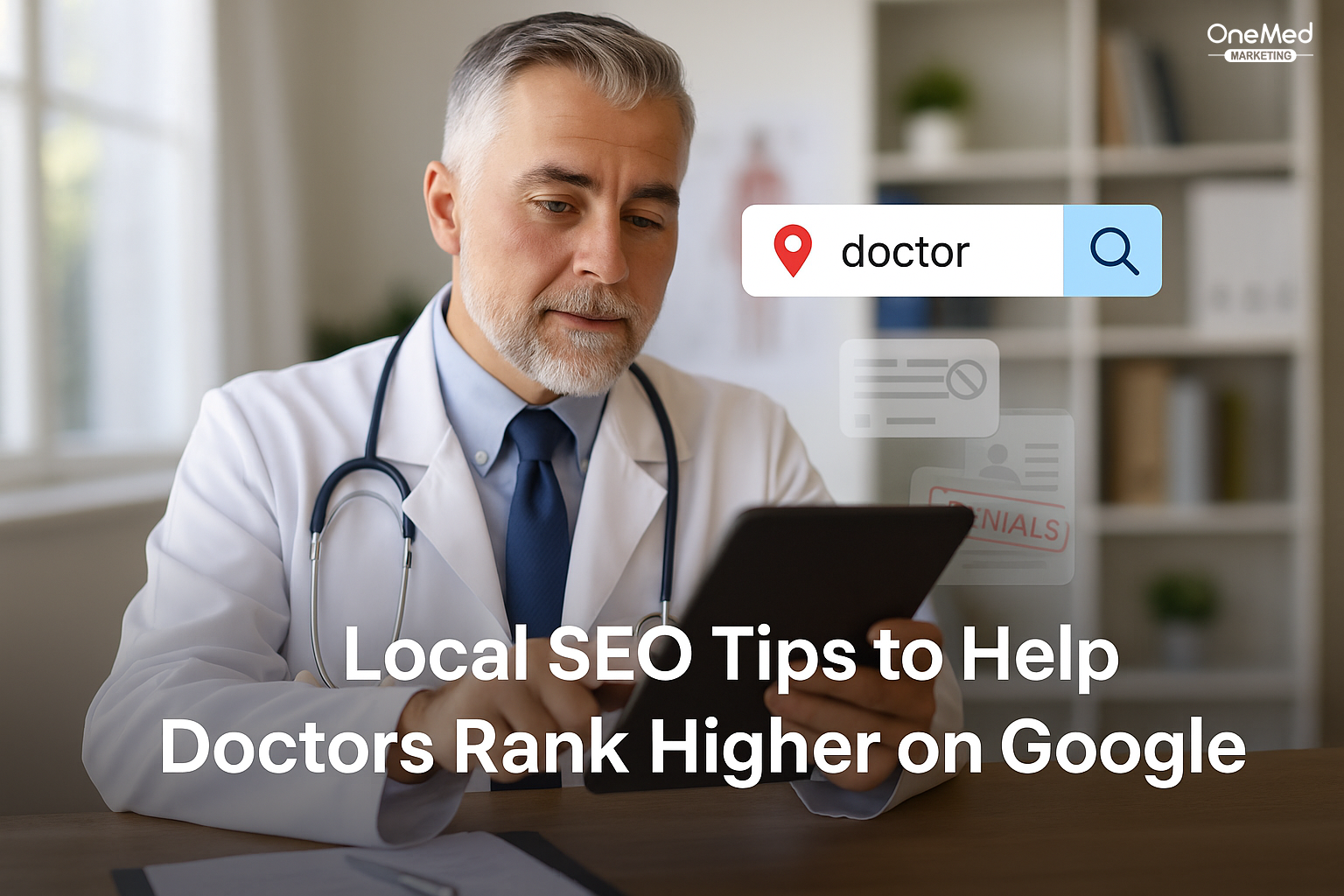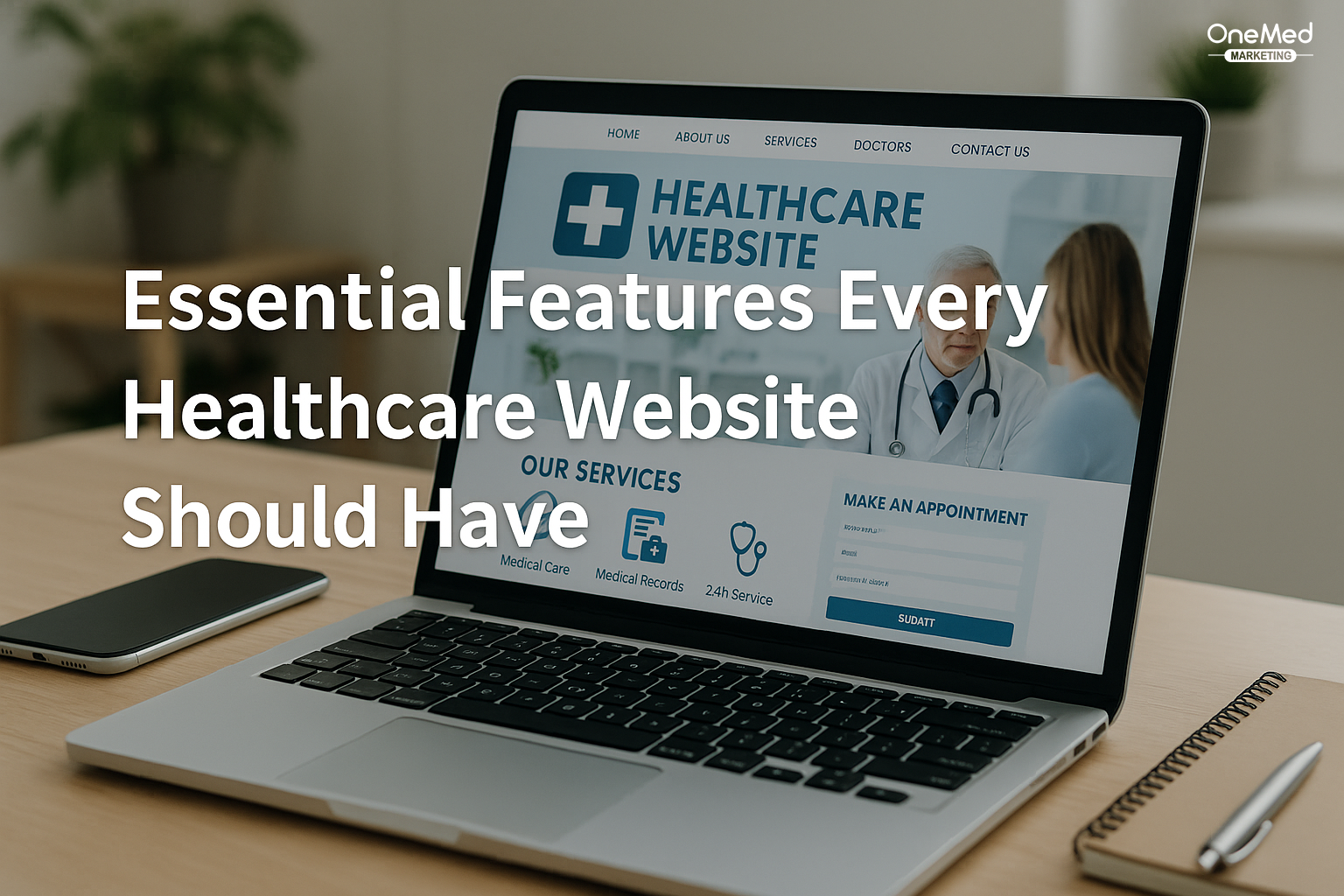- info@onemedmarketing.com
- 4th Floor, Nemours Building, 1007 North Orange St. , Wilmington, DE 19801, United States

Local SEO Tips to Help Doctors Rank Higher on Google
When patients look for a doctor today, the first place they turn is Google. They type in searches like “family doctor near me” or “pediatrician in Dallas,” and within seconds, Google shows them a list of nearby providers. For doctors and clinics, this means that showing up in local search results is no longer optional. It is one of the most important ways to attract new patients and build trust in the community.
Local SEO, or search engine optimization focused on nearby searches, helps doctors rank higher when patients are looking for care in their area. By improving your local SEO, you can make sure your practice is visible, credible, and easy to find online.
In this blog, we will cover the following topics:
- What Is Local SEO for Doctors?
- Optimizing Your Google Business Profile
- Getting More Positive Patient Reviews
- Local Keywords That Attract Patients
- Building Local Citations and Listings
- Creating Location-Specific Content
- Mobile Optimization for Local Searches
- Leveraging Social Media for Local Reach
- Tracking Local SEO Performance
- Common Local SEO Mistakes Doctors Should Avoid
What Is Local SEO for Doctors?
How local SEO differs from general SEO
General SEO focuses on ranking across the internet, but local SEO is about ranking in your specific city or neighborhood. For doctors, this is crucial because patients almost always want care close to home.
Why it matters specifically for healthcare providers
If your practice does not appear in local search results, patients may never even know you exist. A strong local SEO strategy ensures you show up when people are ready to book appointments nearby.
Optimizing Your Google Business Profile
Claiming and verifying your profile
Your Google Business Profile is often the first thing patients see. Make sure you claim it, verify it, and keep it updated.
Adding accurate practice details
Include your practice name, address, phone number, office hours, and website. Small mistakes here can confuse patients or hurt your search rankings.
Using photos and service descriptions
Photos of your clinic, staff, and services make your profile look more inviting. Adding detailed service descriptions also helps patients and improves visibility.
Getting More Positive Patient Reviews
Encouraging patients to leave reviews
After visits, ask patients to share feedback on Google. Even a simple reminder through email or text can increase reviews.
Responding to reviews the right way
Thank patients for positive reviews and address concerns in negative ones. A respectful response shows professionalism and care.
Building trust with consistent feedback
When new patients see dozens of recent reviews, it signals reliability and builds trust before they even call your office.
Local Keywords That Attract Patients
Using city and neighborhood names in keywords
Instead of just “dermatologist,” use “dermatologist in Houston” or “skin clinic near Midtown.” This helps you appear in searches from nearby patients.
Adding location-based terms to service pages and blogs
Service pages and blogs should naturally include local terms. For example, a blog on “managing seasonal allergies” could mention how pollen affects patients in your city.
Creating content that answers local patient questions
Think about what people in your area often search for. A post like “flu shot clinics in Chicago” or “best pediatric care in Atlanta” directly matches local search intent.
Building Local Citations and Listings
Why consistent NAP is important
NAP stands for Name, Address, and Phone number. These details must be the same everywhere online. Inconsistencies confuse Google and can lower your ranking.
Submitting to local directories and healthcare platforms
Add your practice to trusted directories like Healthgrades, Zocdoc, Yelp, and your local Chamber of Commerce. These listings boost visibility and credibility.
Avoiding duplicate or incorrect listings
Clean up duplicate entries or old addresses. Too many errors make it harder for patients to find you.
Creating Location-Specific Content
Writing blog posts about community health topics
Content about local health issues shows you care about your community. A post on “tick season safety in Connecticut” is more relevant than a generic article.
Highlighting local events or partnerships
If your practice sponsors a community health fair or offers free screenings, share it online. This type of content strengthens your local presence.
Adding location landing pages for multi-clinic practices
If you have more than one clinic, create separate pages for each location. Each page should include the address, map, services, and nearby landmarks.
Mobile Optimization for Local Searches
Why patients use phones for nearby providers
Most patients search for doctors while on the go. If your site is not mobile-friendly, they may leave and call another clinic.
Making websites mobile-friendly and fast
Your site should load quickly on mobile devices, with easy-to-read text and simple navigation.
Adding click-to-call and map directions
Features like one-click calling or directions through Google Maps make it easy for patients to reach you without extra steps.
Leveraging Social Media for Local Reach
Sharing health tips with local hashtags
Posting health reminders with local hashtags, like #ChicagoHealth or #MiamiClinic, helps you reach nearby patients on platforms like Instagram and Twitter.
Engaging with community events online
Join conversations about local events or health initiatives. Patients notice providers who are active in their community.
Using Facebook and Instagram to connect with nearby patients
Social media ads targeting specific zip codes or neighborhoods are powerful tools for reaching potential patients close to your clinic.
Tracking Local SEO Performance
Monitoring rankings for local keywords
Tools like Google Search Console or SEMrush can show how your practice ranks for local terms.
Checking website traffic and patient inquiries
Track how many calls, form fills, or appointment bookings come from your website.
Adjusting strategy based on analytics
If a strategy is not working, shift focus. SEO is ongoing, and regular adjustments help maintain strong rankings.
Common Local SEO Mistakes Doctors Should Avoid
Inconsistent contact information
If your address or phone number differs across sites, Google may not trust your listing.
Ignoring reviews or leaving them unanswered
Unanswered reviews make patients feel unheard. Always respond, even if the review is negative.
Forgetting to update Google Business Profile details
Outdated hours or contact information frustrate patients and can cause missed opportunities.
Conclusion
For doctors and clinics, local SEO is one of the most effective ways to attract patients in 2025. By optimizing your Google Business Profile, encouraging reviews, using local keywords, and creating location-specific content, you can make sure your practice shows up when patients search for care.
The key is consistency. Accurate contact details, mobile-friendly websites, and active engagement online all work together to build visibility and trust. Practices that invest in local SEO today will not only rank higher on Google but also build stronger connections with the communities they serve.
Frequently Asked Questions
1. What is local SEO and why does it matter for doctors?
Local SEO is the process of optimizing your online presence so your practice shows up in searches from patients nearby. It matters for doctors because most people look for healthcare providers close to where they live or work.
2. How can a Google Business Profile help a medical practice?
A Google Business Profile gives patients quick access to your address, phone number, hours, and reviews. An updated profile makes your practice more visible in local searches and builds trust with potential patients.
3. What role do patient reviews play in local SEO?
Reviews are one of the strongest ranking factors in local SEO. Positive reviews improve your visibility on Google and help patients feel more confident about choosing your practice.
4. What are common mistakes doctors make with local SEO?
Some common mistakes include inconsistent contact details across websites, ignoring reviews, and failing to update business hours. These issues make it harder for patients to find and trust your practice.







0 Comments
Leave a Comment